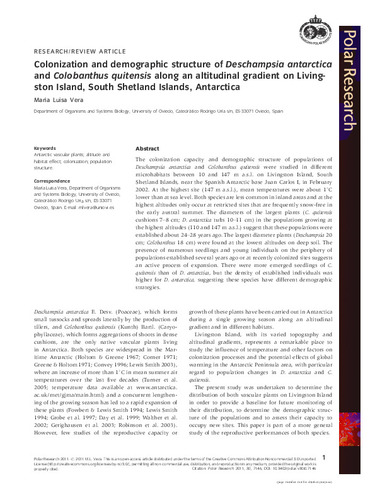Colonization and demographic structure of Deschampsia antarctica and Colobanthus quitensis along an altitudinal gradient on Livingston Island, South Shetland Islands, Antarctica
Autor(es) y otros:
Palabra(s) clave:
Antarctic Vascular Plants
Altitude and Habitat Effect
Colonization
Population Structure
Fecha de publicación:
Editorial:
Co-Action Publishing
Versión del editor:
Citación:
Resumen:
The colonization capacity and demographic structure of populations of Deschampsia antarctica and Colobanthus quitensis were studied in different microhabitats between 10 and 147 m a.s.l. on Livingston Island, South Shetland Islands, near the Spanish Antarctic base Juan Carlos I, in February 2002. At the highest site (147 m a.s.l.), mean temperatures were about 18C lower than at sea level. Both species are less common in inland areas and at the highest altitudes only occur at restricted sites that are frequently snow-free in the early austral summer. The diameters of the largest plants (C. quitensis cushions 7 8 cm; D. antarctica tufts 10 11 cm) in the populations growing at the highest altitudes (110 and 147 m a.s.l.) suggest that these populations were established about 24 28 years ago. The largest diameter plants (Deschampsia 20 cm; Colobanthus 18 cm) were found at the lowest altitudes on deep soil. The presence of numerous seedlings and young individuals on the periphery of populations established several years ago or at recently colonized sites suggests an active process of expansion. There were more emerged seedlings of C. quitensis than of D. antarctica, but the density of established individuals was higher for D. antarctica, suggesting these species have different demographic strategies. Deschampsia antarctica E. Desv. (Poaceae), which forms small tussocks and spreads laterally by the production of tillers, and Colobanthus quitensis (Kunth) Bartl. (Caryophyllaceae), which forms aggregations of shoots in dense cushions, are the only native vascular plants living in Antarctica. Both species are widespread in the Maritime Antarctic (Holtom & Greene 1967; Corner 1971; Greene & Holtom 1971; Convey 1996; Lewis Smith 2003), where an increase of more than 18C in mean summer air temperatures over the last five decades (Turner et al. 2005; temperature data available at www.antarctica. ac.uk/met/gjma/main.html) and a concurrent lengthening of the growing season has led to a rapid expansion of these plants (Fowbert & Lewis Smith 1994; Lewis Smith 1994; Grobe et al. 1997; Day et al. 1999; Walther et al. 2002; Gerighausen et al. 2003; Robinson et al. 2003). However, few studies of the reproductive capacity or growth of these plants have been carried out in
The colonization capacity and demographic structure of populations of Deschampsia antarctica and Colobanthus quitensis were studied in different microhabitats between 10 and 147 m a.s.l. on Livingston Island, South Shetland Islands, near the Spanish Antarctic base Juan Carlos I, in February 2002. At the highest site (147 m a.s.l.), mean temperatures were about 18C lower than at sea level. Both species are less common in inland areas and at the highest altitudes only occur at restricted sites that are frequently snow-free in the early austral summer. The diameters of the largest plants (C. quitensis cushions 7 8 cm; D. antarctica tufts 10 11 cm) in the populations growing at the highest altitudes (110 and 147 m a.s.l.) suggest that these populations were established about 24 28 years ago. The largest diameter plants (Deschampsia 20 cm; Colobanthus 18 cm) were found at the lowest altitudes on deep soil. The presence of numerous seedlings and young individuals on the periphery of populations established several years ago or at recently colonized sites suggests an active process of expansion. There were more emerged seedlings of C. quitensis than of D. antarctica, but the density of established individuals was higher for D. antarctica, suggesting these species have different demographic strategies. Deschampsia antarctica E. Desv. (Poaceae), which forms small tussocks and spreads laterally by the production of tillers, and Colobanthus quitensis (Kunth) Bartl. (Caryophyllaceae), which forms aggregations of shoots in dense cushions, are the only native vascular plants living in Antarctica. Both species are widespread in the Maritime Antarctic (Holtom & Greene 1967; Corner 1971; Greene & Holtom 1971; Convey 1996; Lewis Smith 2003), where an increase of more than 18C in mean summer air temperatures over the last five decades (Turner et al. 2005; temperature data available at www.antarctica. ac.uk/met/gjma/main.html) and a concurrent lengthening of the growing season has led to a rapid expansion of these plants (Fowbert & Lewis Smith 1994; Lewis Smith 1994; Grobe et al. 1997; Day et al. 1999; Walther et al. 2002; Gerighausen et al. 2003; Robinson et al. 2003). However, few studies of the reproductive capacity or growth of these plants have been carried out in
Colecciones
- Artículos [37548]
- Biología de Organismos y Sistemas [776]
Ficheros en el ítem





